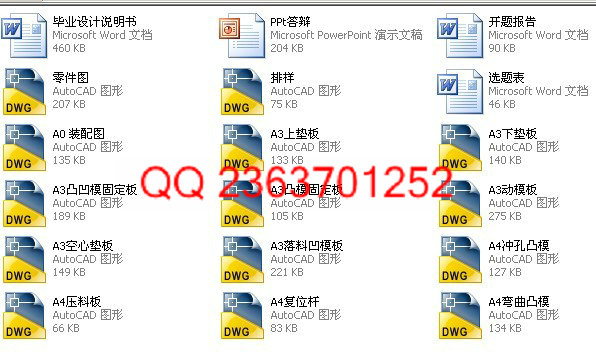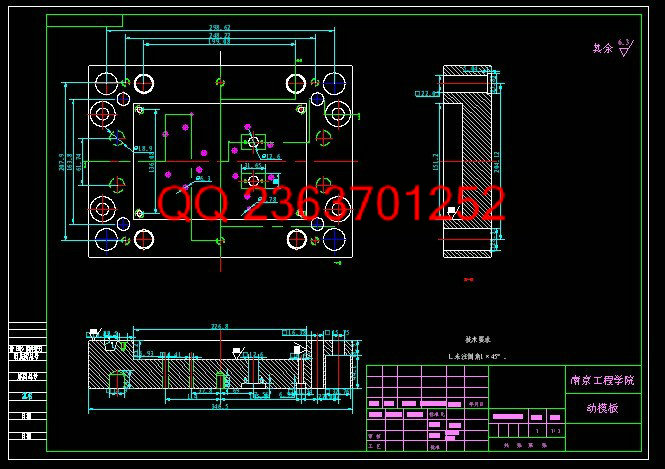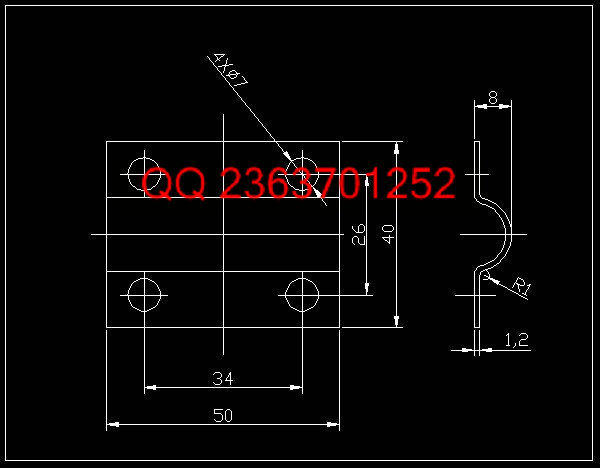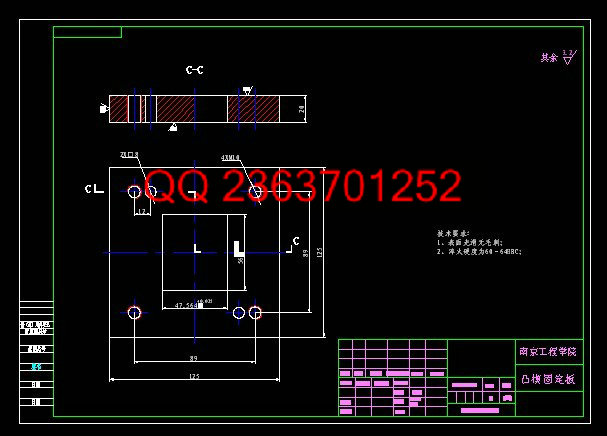|
设计描述:
文档包括:
WORD版设计说明书1份,共50页,约20000字
开题报告一份
PPT答辩一份
CAD版本图纸,共14张
毕业设计说明书(论文)中文摘要
固定夹的复合模设计
本论文应用本专业所学课程的理论和生产实际知识进行一次冷冲压模具设计工作的实际训练从而培养和提高了我的独立工作能力。本设计通过对固定夹的复合模设计的工艺性分析,确定了正确的工艺方案。从而对模具设计方案,以及冲压设备作出了分析与选择。通过分析决定采用复合模形式,然后参考其他模具结构以及查手册和计算设计。当所有的参数计算完后,对模具的装配方案,对主要零件的设计和装配要求技术要求都进行了分析。在设计过程中除了设计说明书外,还包括模具的装配图,非标准零件的零件图,工件的加工工艺卡片,工艺规程卡片,非标准零件的加工工艺过程卡片。
关键词:冷冲压 ;复合模 ;设计
毕业设计说明书(论文)外文摘要
Title Design of compound die for fixing clamp
Abstract:
The application of the professional practical training courses theory and practical knowledge of a cold stamping die design work to develop and improve my ability to work independently. This design through the analysis process of the compound die design of the retaining clip, correct technology scheme was determined. Thus the mold design, and stamping equipment has made the analysis and choice. Through the analysis of decision with compound die form, then the reference other mold structure and manual search and design calculation. When all of the parameter calculation is finished, the mold assembly program, the main parts of the design and assembly requirements of the technical requirements are analyzed. In the design process, in addition to the design specifications, but also including the mold assembly drawing, non-standard parts drawings, the workpiece card processing technology, process cards, process cards non standard parts.
Keywords: Cold stamping compound die; Design;
目 录
毕业设计说明书(论文)中文摘要 I
毕业设计说明书(论文)外文摘要 II
目 录 III
前 言 1
第一章 绪 论 2
1.1 冲压模具的现状 2
1.1.1 模具工业现状 2
1.1.2 模具工业技术结构现状 3
1.1.3 模具工业配套材料,标准间结构现状 4
1.1.4 模具工业产业组织结构现状 5
1.2 模具的发展趋势 5
1.2.1 模具CAD/CAE/CAM的发展方向 5
1.2.2 模具检测、加工设备向精密、高效和多功能方向发展 6
1.2.3 模具工业新工艺、新理念和新模式逐步得到了认同 7
1.3 冷冲压模具分类与特点 7
第二章 零件的工艺分析和工艺方案的确定 9
2.1 冲压弯曲件的工艺分析 9
2.2 确定工艺方案及模具的结构形式 10
2.3 零件的工艺分析 10
2.3.1 计算毛坯尺寸 10
2.4 排样、计算条料宽度及步距的确定 13
2.4.1 搭边值的确定 13
2.4.2 条料宽度的确定 14
2.4.3 导板间间距的确定 15
2.4.4 排样 15
2.4.5 材料利用率的计算: 16
第三章 冲裁力的计算 18
3.1 计算冲裁力的公式 18
3.2 总冲裁力、卸料力、推料力、顶件力、弯曲力和总冲压力 18
3.2.1 总冲裁力: 18
3.2.2 卸料力Fx的计算 19
3.2.3 推料力Ft的计算 20
3.2.4 顶件力Fd的计算 20
3.2.5 弯曲力FC的计算 20
3.2.6 总的冲压力的计算 21
第四章 模具压力中心与计算 22
第五章 冲裁模间隙的确定 23
第六章 刃口尺寸的计算 25
6.1 刃口尺寸计算的基本原则 25
6.2 刃口尺寸的计算 25
6.3 计算凸、凹模刃口的尺寸 26
6.4 冲裁刃口高度 28
6.5 弯曲部分刃口尺寸的计算 29
6.5.1 最小相对弯曲半径rmin/t 29
6.5.2 弯曲部分工作尺寸的计算 29
第七章 主要零部件的设计 33
7.1 工作零件的结构设计 33
7.1.1 凹模的设计 33
7.1.2 凸凹模的设计 35
7.1.3 外形凸模的设计 35
7.1.4 内孔凸模设计 35
7.1.5 弯曲凸模的设计 36
7.2 卸料部分的设计 36
7.2.1 卸料板的设计 36
7.2.2 卸料弹簧的设计 36
7.3 定位零件的设计 38
7.4 模架及其它零件的设计 39
7.4.1 上下模座 39
7.4.2 模柄 39
7.4.3 模具的闭合高度: 40
第八章 模具总装图 41
第九章 压力机的选择 42
结 论 43
参考文献 44
致 谢 45
| 








